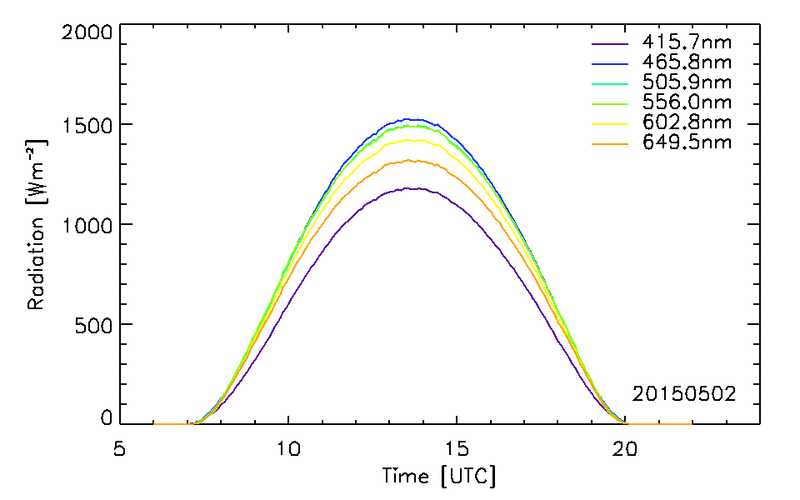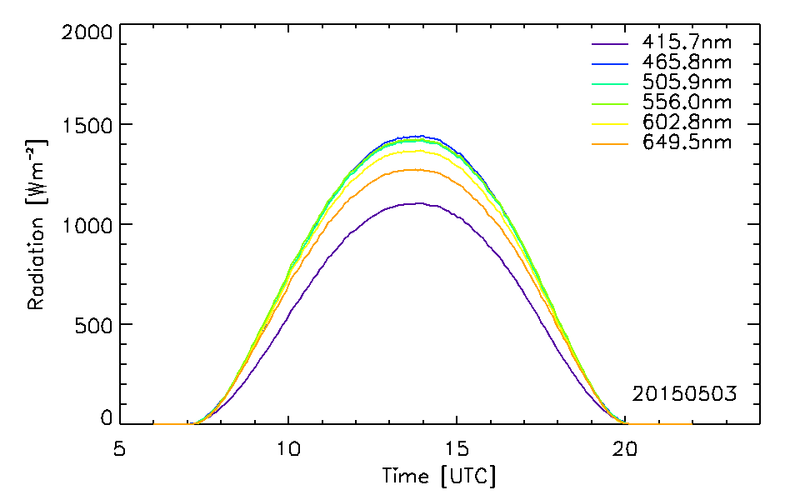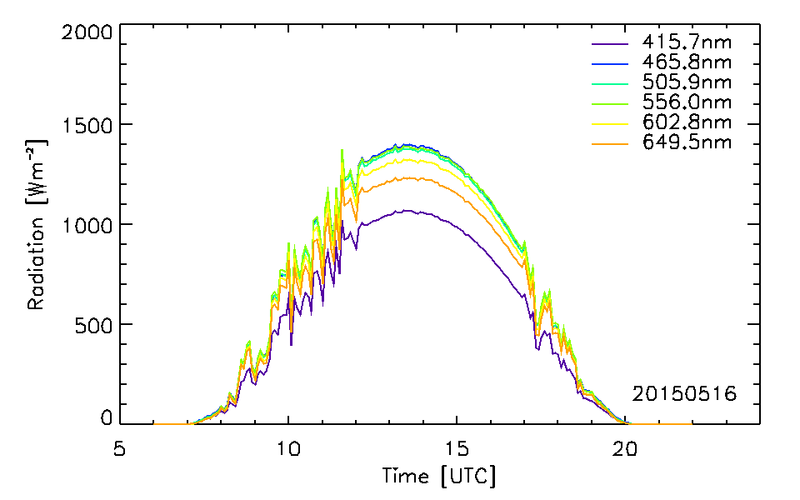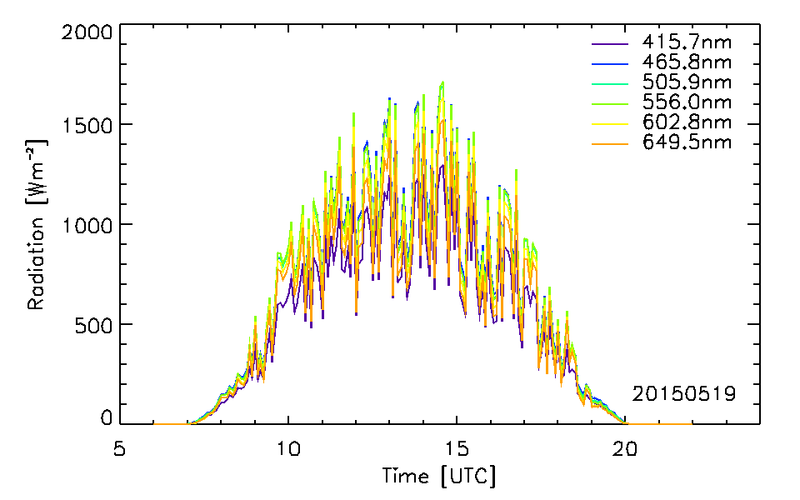Radiance Measurements from SOPRAN UV/VIS Radiometer
Topics
- Access
- Description
- Parameters
- Coverage, spatial and temporal resolution
- Data quality
- Contact person
- References
- Data citation
Access
UNRESTRICTED:
RESTRICTED:This link to the data set is only available for a restricted user group. The data set is only accessible in CEN/MPI net or accessible from external nets with a customer account. Please contact ICDC if you would like to access this data from outside the network.
- Data access via file system: /data/icdc/atmosphere/sopran_uvvis_radiometer
Description
Ground-based spectral solar radiance and irradiance measurements are important for i) validation of satellite measurements in the respective wavelength bands, as e.g. MODIS, and for ii) detailed studies about the temporal (diurnal, seasonal, interannual) variation of the shortwave radiation.
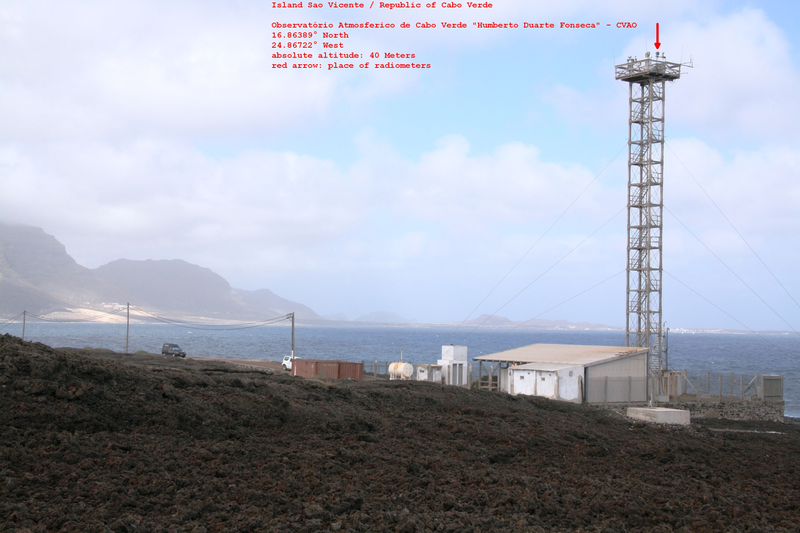
The Institute of Oceanography (IfM) of the University of Hamburg carried out ground-based spectral radiance and irradiance measurements at the research site Cape Verde Atmospheric Observatory (CVAO) Humberto Duarte Fonseca from March 2008 through October 2015. The observatory is located at 16°51'50.43" N, 24°52'3.67'' W close to the village Calhau at the northeastern coast of the island Sao Vicente of the Capverde Islands. The distance of the observatory to the shore is about 50 m, the altitude of the observatory is about 10 m above m.s.l.
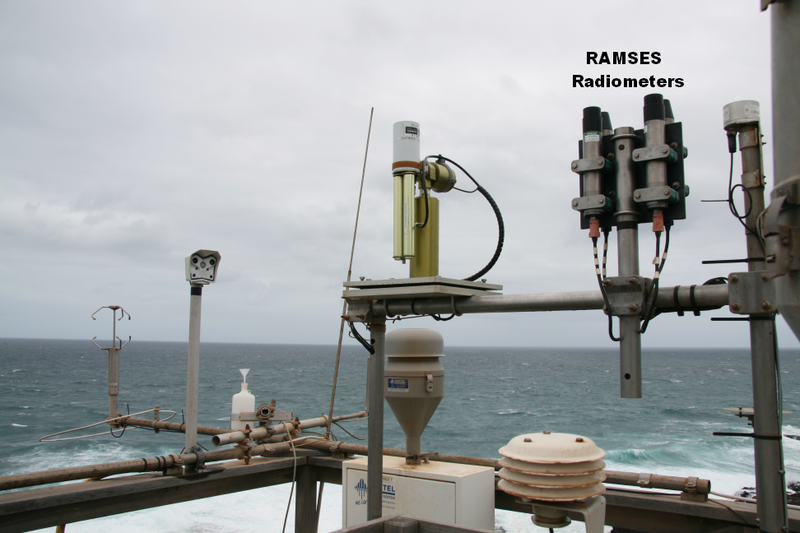
For the UV/VIS radiance measurements two hyperspectral UV-VIS radiance sensors are used (RAMSES-ARC from TriOS); one in a standard configuration and one equipped with a grey filter (see references) to enhance the intensity range. For the UV/VIS and UVA/UVB irradiance measurements a hyperspectral UV-VIS irradiance sensor (RAMSES-ACC-VIS) and UVA/UVB irradiance sensor (RAMSES-ACC-UV) are used (also both from TriOS). Measurements were carried out between 6:00 UTC and 22:00 UTC every day with 5 minute sampling. The wavelength range is 320 to 950 nm (280 to 500 nm for the UV sensor).
Last update of data set at ICDC: March 24, 2016
Parameters
| Name | Unit | Sensor |
|---|---|---|
| Shortwave radiance (zenith) [320-950 nm] | W/m² | 81EB and 81F1 |
| Shortwave irradiance [320-950 nm] | W/m² | 81E8 |
| Shortwave irradiance [280-500 nm] | W/m² | 81F5 |
Coverage, spatial and temporal resolution
Period and temporal resolution:
- Data availability between 2008 through 2015 is shown graphically in RAMSES Availability of Sensors (pdf, not barrier free)
- Daily between 6:00 UTC and 22:00 UTC, every 5 minutes
Coverage and spatial resolution:
- Local, Calhau, Cabo Verde
- Spatial resolution: none, local measurement
- Geographic longitude: 24° 52' 3.67'' W
- Geographic latitude: 16° 51' 50.43" N
- Dimension: 255 columns (wavelengths) x 193 rows (5-minutes time steps)
- Altitudes (location itself is 10 m a.s.l.) 40 m
Format:
- NetCDF
Data quality
The data set does not contain uncertainty estimates. The data are direct measurements. Therefore, most important are the specification of the radiometers - especially in terms of their spectral resolution and its uncertainty. For the sensors 81EB, 81E8, and 81F1, i.e. those operating over the wavelength range 320 nm through 950 nm, the spectral resolution is 3.3 nm with an uncertainty of 0.3 nm. For the UVA/UVB sensor 81F5 the spectral resolution is 2.2 nm with an uncertainty of 0.2 nm.
Since January 24 2012, sensor 81F1 is equipped with a greyfilter (see references). Measurements with this sensor before this date and measurements of the other radiance sensor 81EB are not useful during times with the disc of the sun in the field-of-view of the sensor.
Sensor maintenance and repair caused gaps in the data and you find a graphical illustration of data availability in RAMSES Availability of Sensors (see references). In order to guarantee data which represent the entire diurnal cycle we omit data from those days where measurement gaps amount more than 2 hours; this data is not included in this data set.
We refer to the sensors' data sheets (see references) and to contact Mayk Fischer for more details about the data quality.
Contact
Mayk Fischer
Institute of Oceanography, University of Hamburg
email: mayk.fischer@uni-hamburg.de
phone: +49-40-42838 7436Detlef Stammer
Institute of Oceanography, University of Hamburg
email: detlef.stammer (at) uni-hamburg.de
phone: +49-40-42838 5052Stefan Kern
ICDC / CEN / University of Hamburg
E-Mail: stefan.kern"AT"uni-hamburg.de
References
- Datasheet RAMSES-ACC-VIS (81EB) (pdf, not barrier free)
- Datasheet RAMSES-ACC-UV (81F5) (pdf, not barrier free)
- Datasheet RAMSES-ACR (81E8 and 81F1) (pdf, not barrier free)
- Gehlot, S., P. J. Minnett, and D. Stammer, Impact of Sahara dust on solar radiation at Cape Verde Islands derived from MODIS and surface measurements, Remote Sensing of Environment, 166, 154-162, 2015.
- graphical illustration of data availability in RAMSES Availability of Sensors (pdf, not barrier free)
- Technical information neutral density filter (grey filter) (pdf, not barrier free)
Data citation
Please cite the data as follows:
Gehlot S., Minnett, P. and Stammer, D.: Impact of Sahara dust on solar radiation at Cape Verde Islands derived from MODIS and surface measurements, Remote Sensing of Environment, Volume 166, 154-162, doi:10.1016/j.rse.2015.05.026, 2015;
RAMSES radiation data were obtained for period [YYYYMMDD - YYYYMMDD] in netCDF file format from Integrated Climate Data Center, CEN, University of Hamburg
and the following acknowledgments:
Thanks to ICDC, CEN, University of Hamburg for data support.

